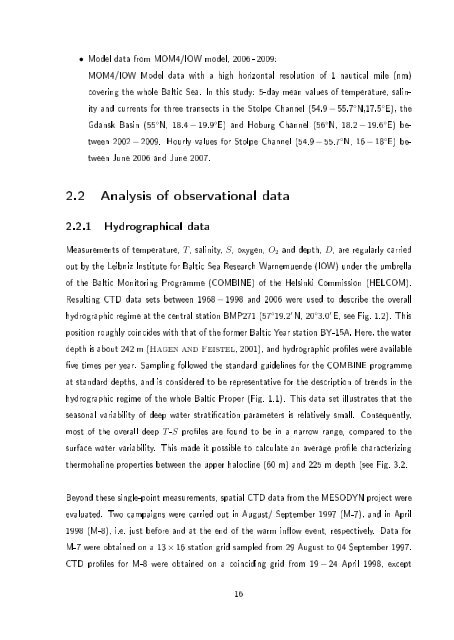Baltic Sea
Baltic Sea
Baltic Sea
Create successful ePaper yourself
Turn your PDF publications into a flip-book with our unique Google optimized e-Paper software.
• Model data from MOM4/IOW model, 2006 - 2009:<br />
MOM4/IOW Model data with a high horizontal resolution of 1 nautical mile (nm)<br />
covering the whole <strong>Baltic</strong> <strong>Sea</strong>. In this study: 5-day mean values of temperature, salinity<br />
and currents for three transects in the Stolpe Channel (54.9 − 55.7 ◦ N,17.5 ◦ E), the<br />
Gdansk Basin (55 ◦ N, 18.4 − 19.9 ◦ E) and Hoburg Channel (56 ◦ N, 18.2 − 19.6 ◦ E) between<br />
2002 − 2009. Hourly values for Stolpe Channel (54.9 − 55.7 ◦ N, 16 − 18 ◦ E) between<br />
June 2006 and June 2007.<br />
2.2 Analysis of observational data<br />
2.2.1 Hydrographical data<br />
Measurements of temperature, T, salinity, S, oxygen, O 2 and depth, D, are regularly carried<br />
out by the Leibniz Institute for <strong>Baltic</strong> <strong>Sea</strong> Research Warnemuende (IOW) under the umbrella<br />
of the <strong>Baltic</strong> Monitoring Programme (COMBINE) of the Helsinki Commission (HELCOM).<br />
Resulting CTD data sets between 1968 − 1998 and 2006 were used to describe the overall<br />
hydrographic regime at the central station BMP271 (57 ◦ 19.2 ′ N, 20 ◦ 3.0 ′ E, see Fig. 1.2). This<br />
position roughly coincides with that of the former <strong>Baltic</strong> Year station BY-15A. Here, the water<br />
depth is about 242 m (Hagen and Feistel, 2001), and hydrographic proles were available<br />
ve times per year. Sampling followed the standard guidelines for the COMBINE programme<br />
at standard depths, and is considered to be representative for the description of trends in the<br />
hydrographic regime of the whole <strong>Baltic</strong> Proper (Fig. 1.1). This data set illustrates that the<br />
seasonal variability of deep water stratication parameters is relatively small. Consequently,<br />
most of the overall deep T-S proles are found to be in a narrow range, compared to the<br />
surface water variability. This made it possible to calculate an average prole characterizing<br />
thermohaline properties between the upper halocline (60 m) and 225 m depth (see Fig. 3.2.<br />
Beyond these single-point measurements, spatial CTD data from the MESODYN project were<br />
evaluated. Two campaigns were carried out in August/ September 1997 (M-7), and in April<br />
1998 (M-8), i.e. just before and at the end of the warm inow event, respectively. Data for<br />
M-7 were obtained on a 13 × 16 station grid sampled from 29 August to 04 September 1997.<br />
CTD proles for M-8 were obtained on a coinciding grid from 19 − 24 April 1998, except<br />
16



